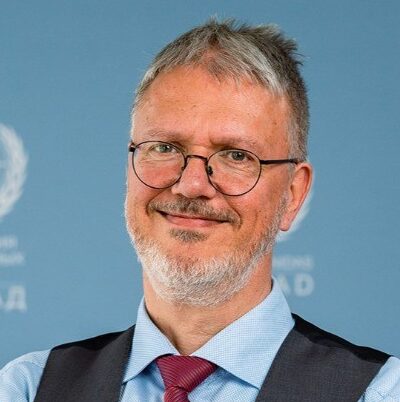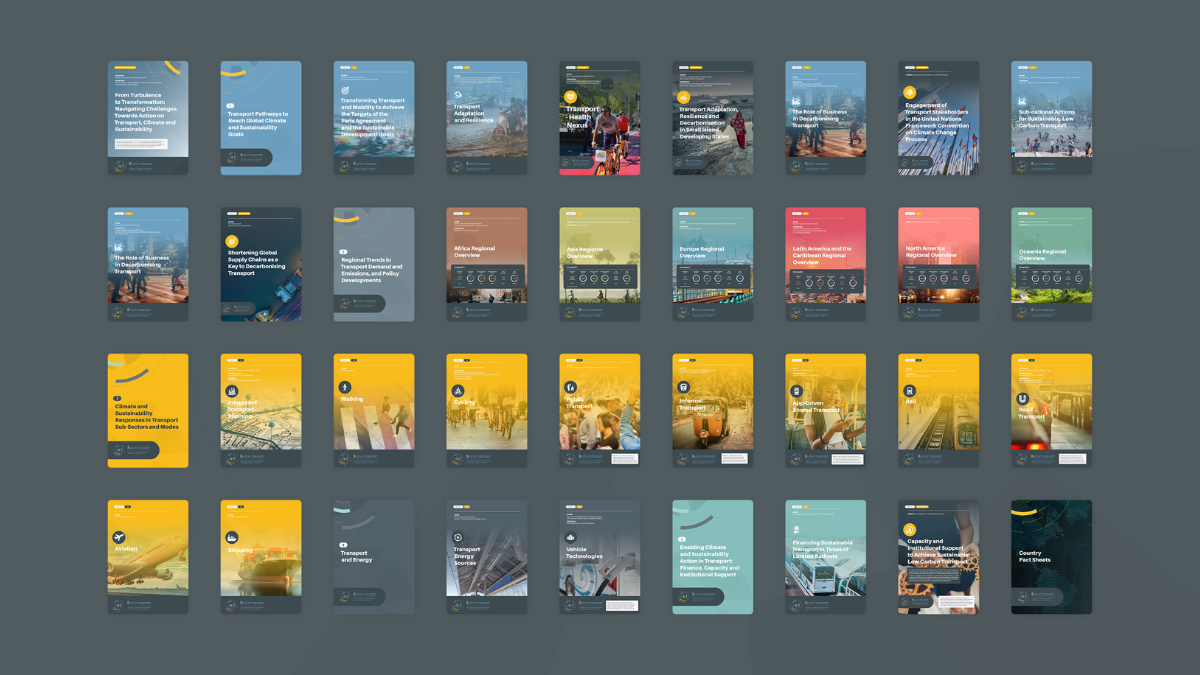The GSR Collection
The third edition of this biennial flagship report tells the global and regional stories of where we are and where we need to get to urgently on climate and sustainability action for transport and mobility. With contributions from 100 world-class experts and organisations, the GSR is a one-stop shop for the latest available data, trends, targets and developments on transport demand, emissions and policies. The GSR equips decision makers towards knowledge-based action and aims to raise ambition in transport policy and investment for people and the planet.
The sections of this biennial report were gradually released in modules, up to the final release of the full report and its Takeaways for Decision Makers in September 2023. Additionally, a series of thematic, sectoral and regional briefs, infographics, country factsheets and podcasts convey the report’s findings and their implications for transport, climate and sustainability.
Zooming In
Focus on some key trends, challenges and opportunities
Freight transport and logistics
Recognising the essential role of freight transport in sustainable trade and development, this paper aims to shed light on the data, knowledge, policy and finance needs to further strengthen freight systems that efficiently combine different low-carbon modes, share capacities and rely on sustainable first and last mile delivery. The brief was produced in cooperation with the Kühne Climate Center. Read
A just transition for transport workers
A just transition to equitable, healthy, green and resilient transport and mobility systems is central to socioeconomic prosperity for the people and the planet. A just transition secures the future and livelihoods of workers and their communities during the transition to a low carbon economy, effectively limiting global temperature rises to 1.5°C above pre-industrial levels.
The analysis developed by SLOCAT and the International Transport Workers’ Federation shows that less than 20% of NDCs mention a just transition in the transport sector. Even when specific provisions for transport are included, the needs and roles of workers in rail, road, urban transport, aviation, and maritime are generally ignored.
Economics for transport
This piece summarises the key trends in land transport financing and outlines the challenges and opportunities for scaling up economic appraisals anchored on wide sustainability criteria. This piece is a collaboration between SLOCAT and the Transport Urban Mobility Initiative (TUMI)
Regional insights
Tough Questions, Smart Answers on All Things Transport, People and Planet
Voices across generations of change makers
Tough Questions, Smart Answers on All Things Transport and Planet is a space curated by the SLOCAT Partnership on Sustainable, Low Carbon Transport for and by professionals, experts and change makers. Collectively, these blogs and storytelling products feature world-class thought leadership and experience on how to enable systemic transformations and a just transition towards equitable, healthy, green and resilient transport and mobility systems for the people and the planet.
Our podcast series will bring together voices across generations of change makers to deepen our understanding on prevailing, burning and emerging issues in the intersection of transport, climate and sustainability.
The podcasts are developed with the SLOCAT-VREF Young Leaders in Sustainable Transport programme, which aims to equip young professionals with skills in evidence-based policy analysis; and the interface between knowledge production and policy making.
From pledges to progress: Scaling up climate finance for sustainable, low-carbon transport
To develop modern transport networks that drive economic growth, improve connectivity, and enhance the quality of life for residents, we must rethink and scale up transport financing strategies.
Despite being the largest recipient of global infrastructure investment, the transport sector still faces a significant gap. Much of the current investment has gone into road construction and motorway expansion, which supports rising motorisation rates but doesn't necessarily improve travel conditions or opportunities.
International finance specifically for the transport sector did see an increase, from USD 136 billion in 2017-2018 to USD 169 billion in 2019-2020, but it is still not enough. Estimates suggest that improving the efficiency of road transport to keep global temperature rise within 1.5°C by 2050 would cost USD 3 trillion. Meanwhile, tracked climate financing averaged USD 585 billion annually in 2019 and 2020—far less than the amount required to meet global goals. Even with substantial pledges to boost multilateral financing, only a small portion of these funds is allocated to transport decarbonisation projects. Fossil fuel subsidies, which rose by 27% in 2021 to USD 227 billion, also need to be redirected towards sustainable, low-carbon transport models.
As COP29 approaches, setting a new climate finance goal is on the horizon to mobilise and deliver the necessary funds to meet the needs of developing countries. How can the transport sector seize this opportunity to scale up financing for sustainable, low-carbon projects?
Join us in this podcast as our speakers delve into what it takes to improve access to climate finance for the transport sector.
Meet the speakers

Ben Welle
Director of Integrated Transport & Innovation
World Resources Institute

Ragina Gitau
Urban Finance Consultant at UN-Habitat
and SLOCAT-VREF Young Leader in Sustainable Transport
Integrating urban electric mobility solutions - What does it take?
Replacing the current fossil-fuelled road transport fleet with low-emission vehicles – powered by electrification, hydrogen, biofuels, and e-fuels – is a key strategy for decarbonising transport. But the impact of these low-emission vehicles on climate change mitigation and sustainable development hinges on their integration with other parts of the system. To be truly effective, these vehicles must be fit-for-purpose, both resource- and energy-efficient. This highlights the potential of electric micro-mobility options, such as two- and three-wheelers, and a diverse range of four-wheelers, including two-seaters, small vans, trucks, and light electric freight vehicles.
Although low-emission vehicles are a crucial aspect of decarbonising the land transport sector, they are not a sufficient solution. A wider agenda is needed that goes beyond electric cars to address electric two- and three-wheelers, public transport, and freight (particularly in low- and middle-income countries) – and that is aligned with the energy transition towards renewables.
In this podcast, our speakers will share their insights on how SOLUTIONSplus has created a global platform for shared, public, and commercial e-mobility solutions, setting the stage for a transition towards low-carbon urban mobility. We will hear their hands-on stories on how to integrate different types of e-mobility in large urban areas and address user needs and local conditions.
Meet the speakers

Oliver Lah
Head of the Mobility and International Cooperation Unit
Wuppertal Institute

Maria Rosa Muñoz
Senior Researcher
Wuppertal Institute

Spencer S. Taylor, Jr.
Director of Climate Change and Environment
Ministry of Transport in Liberia
En route to low-carbon, sustainable and resilient freight transport and logistics
Accelerating the transformation of freight transport and logistics is among the most impactful steps the global community can take to enable overall positive socio-economic transformations by mid-century. Achieving low-carbon transport pathways that limit global warming to 1.5°C will require a 59% reduction in transport-related CO2 emissions by 2050, compared to 2020 levels, and freight transport and logistics play an indispensable role in this ambitious pathway.
However, as the laggard among sectors, the transport sector had the highest increase in global emissions with 18% growth from 2010 to 2019. Freight transport emissions comprise a rising share accounting for 42% of global transport CO2 emissions in 2019. Moreover, the COVID-19 pandemic, geopolitical tensions, energy supply pressures, inflation, increased volatility of shipping costs and extreme climate events are revealing the increased vulnerability of freight systems and their workforces and how this impacts on food security and on the capacities for emergency response and economic recovery of countries.
While the demand for transporting goods is forecasted to double between 2019 and 2050, over the next decades, changes in populations, climate, behaviour, energy sources, workforces, production and consumption location, and technology will have dramatic impacts on freight transport and logistics. Frequent extreme weather events and rising sea levels also inflict huge financial losses through direct damage to freight transport assets and, to a greater extent, through freight transport disruptions, as USD 107 billion were lost annually to businesses in LMICs.
In light of these pressing challenges, SLOCAT and Kühne Foundation, together with CONCITO, IDDRI, International Transport Workers’ Federation, Smart Freight Centre, UIC International Union of Railways and World Resources Institute have co-initiated a manifesto for intermodal, low-carbon, efficient and resilient freight transport and logistics. The manifesto was launched at the first United Nations Global Supply Chain Forum organised by United Nations Trade and Development and the Government of Barbados from 21– 24 May 2024.
In this podcast, our speakers come together for an insightful conversation to explore what it takes to accelerate the transformation of freight transport and logistics. Learn how we can help our economies and societies tackle climate change while staying competitive, equitable, and resilient.
Meet the speakers

Jan Hoffmann
Chief, Trade Logistics Branch, Division on Technology and Logistics
UN Trade and Development

Marc Jonathan Douanla Fotseu
Transport Consultant
World Bank Group
Addressing critical mobility challenges in Africa and Asia
Asia and Africa face critical mobility challenges that impact economic growth, environmental sustainability, and public health. Asia experiences rapid urbanisation and motorisation, resulting in significant traffic congestion and negative externalities such as economic losses, increased fossil fuel consumption, deteriorating air quality, and road fatalities. The motorisation rate in developed Asian countries ranges from 417 to 819 vehicles per 1,000 inhabitants, while in developing countries, it ranges from 22 to 38 vehicles per 1,000 inhabitants. Traffic congestion imposes an economic cost of 2 to 5% of GDP annually, highlighting the urgent need for sustainable transport solutions and improved urban planning.
Meanwhile in Africa, rapid urbanisation and low motorisation rates, with only 43 vehicles per 1,000 people compared to the global average of 197 vehicles per 1,000 people, lead to a heavy reliance on walking, cycling, and informal transport, especially among low-income households. However, even these modes face significant challenges, as 95% of Africa's roads fail to provide an acceptable level of service for pedestrians, and 93% fail for cyclists. Limited access to formal and informal public transport is also a concern, with only 31.7% of the population able to access public transport within a reasonable walking distance. Both regions also grapple with road safety challenges, with vulnerable road users such as pedestrians, cyclists, and motorcyclists accounting for a substantial portion of road traffic fatalities.
Meet the speakers

Masimba Tutsie Mapfurira
PhD Researcher
University of Johannesburg
Stride & ride: Paving the path to active travel and health
An estimated 20-30% of all trips globally are made on foot, while a significant 85% of all trips involve walking. Walking and cycling represent the most sustainable forms of transportation. Encouraging more people to walk and cycle safely can significantly contribute to achieving climate goals. It provides a swift, cost-effective, and reliable means to reduce transport emissions, improve public health, boost the economy, and foster a more just and equitable society. Furthermore, walking and cycling serve as feeder modes for accessing other sustainable transportation options, such as public transit.
Commuting between work and home accounts for a substantial portion of cycling trips, surpassing other purposes. In urban areas, cycling to work is on average 40% more prevalent than cycling for non-work-related trips. This figure escalates to approximately 60% in larger cities. However, a notable gender disparity in cycling exists worldwide, with women and girls cycling significantly less than men. Various factors contribute to this gap, including limited access to bicycles, cultural or religious considerations, and insufficient safe cycling infrastructure and knowledge.
The primary obstacles to cycling include the absence of segregated lanes, inadequate safe infrastructure, concerns about physical fitness, and negative perceptions of cyclists. Investing in infrastructure that promotes walkability and bikeability is crucial for promoting active travel and enhancing public health.
In this podcast, we will explore Zambia's experiences in promoting walking and cycling initiatives and the lessons learned from their endeavours.
Meet the speakers

Chilekwa O'Brien
Research Evaluation Associate
Zambia Road Safety Trust - PATH Partnership for Active Travel and Health

Carol Masingi
PhD Researcher
University of Groningen
Want to collaborate with us? Contact Alice Yiu

